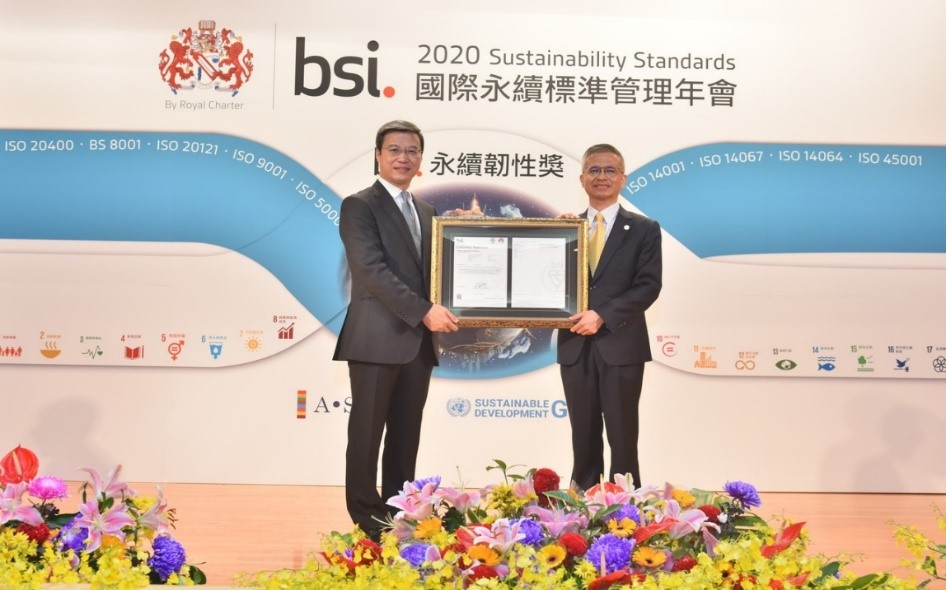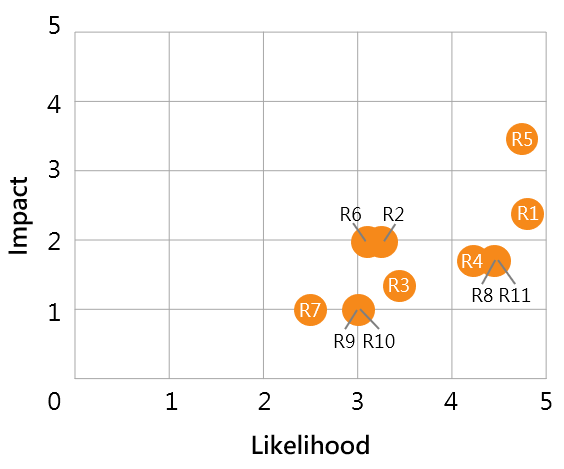Customer Care
TCFD
Climate Change Risks and Opportunities
In response to global climate change, United Nations adopted Paris Agreement and Sustainable Development Goals (SDGs), climate change mitigation and adaptation have become the key for global economic development.
In order to promote transparency in the disclosure of climate-related risks and opportunities, CHT is the first telecommunication industry’s company for the Supporter of Task Force on Climate-Related Financial Disclosures (TCFD). In 2020, CHT has started to analyze climate-related risks and opportunities in accordance with the TCFD’s recommended framework, and accordingly promote climate change mitigation and adaptation, in order to continuously reduce climate-related risks and create opportunities for the industry.
CHT became the first telecommunication industry’s company in the global to achieve the " Task Force on Climate-Related Financial Disclosures (TCFD) Conformity Statement" and won the highest level-"Level 5: Excellence".

Disclosure of TCFD
CHT has carried out the analysis of climate-related risks and opportunities in accordance with the TCFD’s recommended framework, and CHT has obtained preliminary achievement. CHT illustrates the following achievement based on the four core elements of TCFD, "Governance", "Strategy", "Risk Management", " Metrics and Targets".
Governance
CHT’s Risk Management Committee was established under the board of directors with the President as the chairperson. The risk management committee has a dedicated climate change risk strategy group. The strategy group tracks climate change risk monthly and reports the assessment and analysis results of the climate change risk to the risk management committee. The Risk Management Committee will comprehensively assess the climate-related risk and other risks of the company and conduct necessary mitigation measures depending on the impact of risk. The strategy group will periodically produce TCFD assessment reports to the board of directors for reference in operational decision-making.
Strategy
According to the TCFD framework, CHT analyzes the short-term, medium-term, and long-term climate-related risks and opportunities in the scope of operations, upstream and downstream, as well as the entire life cycle of assets. The main impact of physical risks is the damage of extreme climate events on telecommunication equipment and building facilities, so the operating cost is raised. The main impact of transition risk is the national policy is moving towards a low-carbon economy, such as gradually increasing the use of renewable energy, so CHT must purchase renewable energy to comply with policy and/or regulations. CHT also has analysis the opportunity bought from climate change, the main climate opportunity is “popularization of emerging technologies like 5G, IoT, and big data to drive the industrial transformation”.
|
Category |
Physical Risks |
Transition Risks |
|
Climate scenarios |
RCP 2.6 |
IEA SDS |
|
Main Risk |
Increased frequency and severity of heavy rains and floods, resulting in equipment inoperability and service interruption |
In response to regulatory trends, CHT uses renewable energy |
|
preventive solution |
CHT conducts climate scenarios analysis according to RCP 2.6 and the "National Climate Change Adaptation Action Plan (2018-2022)" formulated by the Executive Yuan. In further, CHT uses the Taiwan Climate Change Projection Information and Adaptation Knowledge Platform (TCCIP) as an analysis tool, and carries out the " Telecommunication Adaptation Action Plan for climate change adaptation ", are thus unfolded with 3 axes: 1) flood /disaster prevention action plan for telecom IDCs, equipment, and facilities; 2) climate change adaptation action plan for line facilities; and 3) climate change adaptation action plan for mobile base station networks in the next 20 years. With the Action Plans, CHT takes actions to increase the climate change resistance to reduce loss and avert operation discontinuity due to the risks. |
CHT uses IEA SDS as the climate scenario, and comply nation regulation, such as “Greenhouse Gas Reduction and Management Act” states the national GHG target (50% reduction of GHG emissions by 2050 compared with 2005 levels) and a fine up to NT$1,500/tonne GHG emissions if enterprise exceeds the emission ceiling, and “Renewable Energy Development Act” requires that enterprises shall implementation of renewable energy if the chartered capacity on agreements exceed 5,000 kW. In line with the TCFD, IEA WEO and ETP and SBT ICT standards, CHT underwent the climate change tactical planning. Also, CHT plans to establish a green energy office, which will in charge of purchase renewable energy and installed capacity. In order to reduce emission, CHT import high-efficiency telecommunication facilities, low-carbon base stations and adopt low-carbon product equipment with government's green label. Meanwhile, CHT joined CDP Supply Chain Program and executed carbon management actions together By the end of 2020, CHT’s installed capacity of renewable energy has exceeded 2,783 kWp and our energy saving target is 1% year over year. |
|
Main opportunity |
popularization of emerging technologies like 5G, IoT, and big data to drive the industrial transformation |
|
Description |
The global transition of low-carbon economy and the COVID-19 impact in 2020 ushered in opportunities for ICT. To expedite the industrial transformation and upgrade, the Taiwanese government proposed The “5+2 Innovative Industries Plan”, it is including the creation of IoT innovative ecosystem, which is precisely one of the core businesses of CHT. |
|
Preventive solution |
To assist company towards to low-carbon economy, CHT provides low-carbon solutions, which include energy makeover of smart cities, smart factories, smart buildings by using innovative ICT technologies, like 5G, IoT, big data. |
Risk Management
In 2020, the climate change risk strategy group was implementing the climate change project. Referring to the ISO 31000 risk management guidelines, the strategy group assess the hazard caused by each climate-related risk (risk hazard = likelihood × impact), through Delphi method, which investigates the professional experience of senior executives in related departments, and focuses on the likelihood from five levels, which are "very unlikely", "unlikely", "probable", "likely" to "very likely", and the degree of impact is divided into five levels based on the proportion of CHT’s paid-in capital, which are "extremely high", "very high", "high", "moderate", and "minor". As the result for identifying of climate-related risk, there is 6 transition risks and 5 physical risks.

After analyzing low, medium, and high risks, the Risk Management Committee will comprehensively assess the climate-related risk and other risks of the company and conduct necessary mitigation measures depending on the impact of risk. After the Risk Management Committee conducts an overall risk assessment based on the evaluation and analysis results, the Chief Auditor shall review the risk assessment results and the Risk Management Committee will report to the Board of Directors.

|
No. |
Climate Risk |
Level |
|
R1 |
Increase in operating costs due to the carbon emissions pricing |
High |
|
R2 |
Higher electricity rate due to change in Taiwan’s structure of electricity generation |
Medium |
|
R3 |
Increase in operating costs as replacing low energy-consuming equipment ahead of time to improve energy efficiency |
Medium |
|
R4 |
Increase in operating costs as replacing fuel vehicles with electric ones to improve energy efficiency |
Medium |
|
R5 |
Increase in operating costs due to the adoption of renewable energy forced by updated regulations |
High |
|
R6 |
Losing the favor of investors and consumers because of lacking active sustainable actions |
Medium |
|
R7 |
Operational assets are damaged owing to the rise of sea level covering the low-lying coastal areas |
Low |
|
R8 |
Tense operating pressure and serious impact due to lack of water resource |
Medium |
|
R9 |
Decrease of international service revenue due to worsening environment which deters tourists from visiting Taiwan |
Low |
|
R10 |
Employees’ leaving their jobs forced by rising temperature |
Low |
|
R11 |
Equipment inoperability and service interruption resulting from increased frequency and severity of heavy rains and floods |
Medium |
Metrics and Targets
In according to the climate-related risk, CHT has established targets for climate change adaptation and mitigation.
|
Targets for climate change adaptation |
targets for climate change mitigation |
|
In according to "National Climate Change Adaptation Action Plan (2018-2022)“ CHT conducts climate change adaptation and establish the targets, which are : (1) Increase the survival rate of base stations after the climate-related disaster to 96%; (2) Increase the overall capacity of mobile emergency communication services to 1.5 times. Note: (1) The survival rate of base stations after the climate-related disaster refers to the ratio of the number of non-faulty base stations in the country to the total number of base stations. (2) The multiple ratio of overall capacity of mobile emergency communication services is comparing to the number of vehicular mobile base stations in 2016. |
In order to achieve the goal of green enterprise, CHT uses the national policy, which is Four Saving Aspects (power, fuel, water, paper) Project, and reduce that 1% with rolling base year. In 2021, CHT will submit the SBTi commitment, and according to the new standard of SBT ICT target to submit emission reduction target. |

